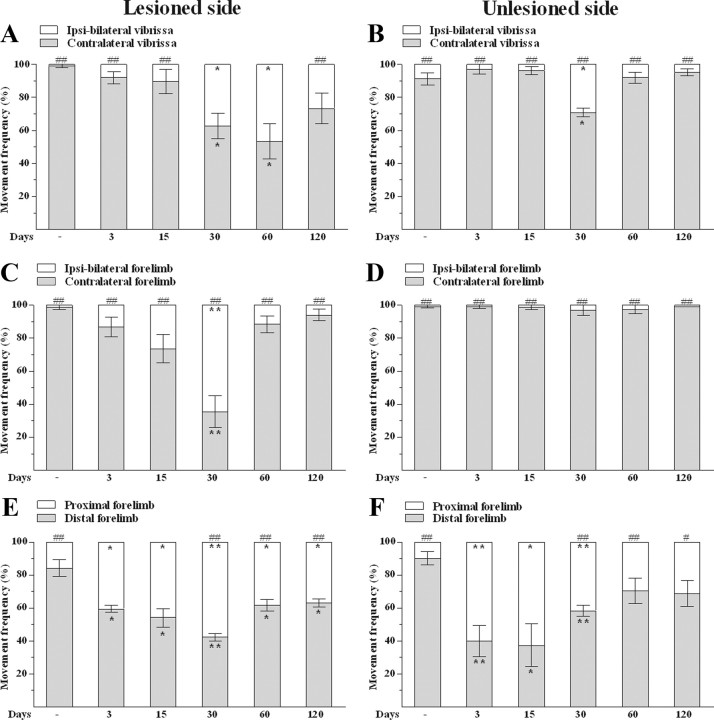Figure 4.
Unilateral 6-OHDA injection in rats changed the type of ICMS-evoked movements. 6-OHDA affected the frequency of ipsi-bilateral and contralateral vibrissa (A, B) and forelimb (C,D) movements as well as the frequency of distal and proximal forelimb movements (E–F) in both the lesioned side and unlesioned side. All measures were performed in control and 6-OHDA rats at 3, 15, 30, 60, and 120 d after lesion. Data are means ± SEM of five determinations per group and are expressed as percentage of total movements. Statistical results: A, Effect of treatment (F(1,4) = 217.30, p = 0.0001) but not of time (F(5,40) = 0.01, p = 0.99) and time × treatment interaction (F(5,40) = 10.68, p < 0.0001). B, Effect of treatment (F(1,4) = 1490.55, p < 0.0001) but not time (F(5,40) = 0.01, p = 0.99), and time × treatment interaction (F(5,40) = 21.87, p < 0.0001). C, Effect of treatment (F(1,4) = 98.11, p = 0.0006) but not time (F(5,40) = 0.01, p = 0.99) and time × treatment interaction (F(5,40) = 27.88, p < 0.0001). D, Effect of treatment (F(1,4) = 7332.12, p < 0.0001) but not time (F(5,40) = 0.01, p = 0.99) or time × treatment interaction (F(5,40) = 0.85, p = 0.52). E, Effect of treatment (F(1,4) = 91.80, p = 0.0007) but not time (F(5,40) = 0.01, p = 0.99) and time × treatment interaction (F(5,40) = 23.90, p < 0.0001). F, No effect of treatment (F(1,4) = 6.03, p = 0.07) or time (F(5,40) = 0.01, p = 0.99), but significant time × treatment interaction (F(5,40) = 13.96, p < 0.0001). *p < 0.05, **p < 0.01 different from control; #p < 0.05, ##p < 0.01 different from contralateral (A–D) or distal (E, F) movements (RM ANOVA followed by contrast analysis and the sequentially rejective Bonferroni's test for multiple comparisons).

